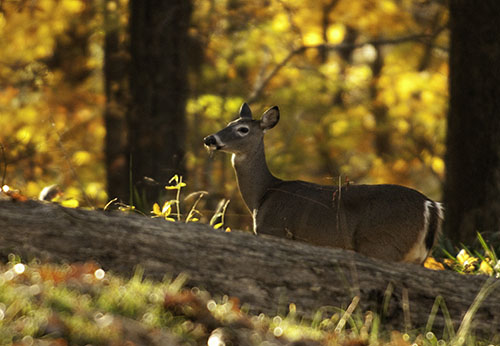Oh Deer! Tips for Fall Deer Feeding
Oct 04, 2021

Fall is breeding season for deer, which means they have a higher demand for energy. In the winter, natural forage becomes more scarce and icy grounds can limit the deer’s ability to naturally browse. Making feed easily accessible to deer during fall and winter keeps them healthy and bridges the gap between winter and spring.
Make sure to give the deer time to adapt to unfamiliar foods by first feeding them in small amounts and then increasing the volume. Shifting from a forage-based diet to a high concentrate-based diet such as corn can quickly lead to bloat or acidosis, a nutritional disorder that can then lead to death. Alfalfa can also be hard for deer to digest in large amounts, so make sure they are slowly introduced to this feed source as well.
Oats are a preferred supplement for fall deer feeding due to its high protein content, and feeding a mixture of oats and barley is a popular practice as well. Salt and mineral licks can also be provided throughout the winter to help the deer’s bodies adapt to the colder weather. Additionally, deer love to snack on a wide variety of fruits and vegetables such as apples, grapes, small plums, cherries, pears, pumpkin, carrots, snap peas, tomatoes, squash, almonds, watermelon, and persimmons.
Planting food plots is another effective and legal way to support local deer populations. Consider incorporating them onto your property with cereal grains such as oats and wheat or cool season legumes such as clover and alfalfa.
Feeding deer can increase the transmission of diseases such as chronic wasting disease. Reduce the probability of transfer by using above-ground, covered feeders that keep the food away from harmful toxins or feces that could contaminate the food. If food must be placed on the ground, reduce food pile density and distribute it across a larger area.
Deer baiting for the purpose of hunting is illegal in Tennessee, so make sure to read more about state rules and regulations at TWRA.com. Visit your local Co-op for great outdoor products and top-level knowledge on fall deer feeding and food plot management.
For more content like this, check out the latest issue of the Cooperator.
Make sure to give the deer time to adapt to unfamiliar foods by first feeding them in small amounts and then increasing the volume. Shifting from a forage-based diet to a high concentrate-based diet such as corn can quickly lead to bloat or acidosis, a nutritional disorder that can then lead to death. Alfalfa can also be hard for deer to digest in large amounts, so make sure they are slowly introduced to this feed source as well.
Oats are a preferred supplement for fall deer feeding due to its high protein content, and feeding a mixture of oats and barley is a popular practice as well. Salt and mineral licks can also be provided throughout the winter to help the deer’s bodies adapt to the colder weather. Additionally, deer love to snack on a wide variety of fruits and vegetables such as apples, grapes, small plums, cherries, pears, pumpkin, carrots, snap peas, tomatoes, squash, almonds, watermelon, and persimmons.
Planting food plots is another effective and legal way to support local deer populations. Consider incorporating them onto your property with cereal grains such as oats and wheat or cool season legumes such as clover and alfalfa.
Feeding deer can increase the transmission of diseases such as chronic wasting disease. Reduce the probability of transfer by using above-ground, covered feeders that keep the food away from harmful toxins or feces that could contaminate the food. If food must be placed on the ground, reduce food pile density and distribute it across a larger area.
Deer baiting for the purpose of hunting is illegal in Tennessee, so make sure to read more about state rules and regulations at TWRA.com. Visit your local Co-op for great outdoor products and top-level knowledge on fall deer feeding and food plot management.
For more content like this, check out the latest issue of the Cooperator.